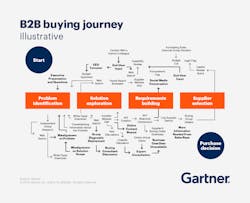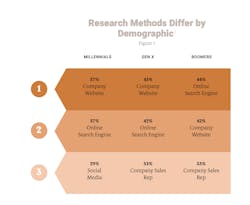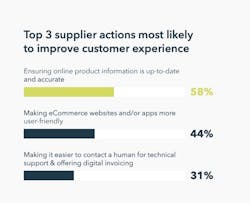Ecommerce for Manufacturers: A Quick-Start Guide To Set Up Online Operations
Henry Ford reimagined the automotive sector with the conveyor belt. Jacob Davis and Levi Strauss persuaded the world to wear durable denim over wool and textile. Today, brands like Nike and Audi and Siemens are honing their fully automated smart factory solutions.
These visionary leaders have challenged the status quo and ignited a true revolution in the manufacturing industry.
But amid rapid changes in production, some manufacturers, especially in the B2B space, may be overlooking the need for digital transformation, as B2B (business-to-business) buyers now expect online experiences that mimic those of B2C ecommerce.
This is where manufacturer ecommerce comes into play.
A manufacturer is a company that produces goods for sale from raw materials and sells them to customers, wholesalers or distributors. Thus, manufacturer ecommerce is specifically geared toward manufacturers and distributors, addressing their specific needs and working to make business processes more efficient.
According to a 2021 PwC survey, two-thirds of U.S. manufacturers said that implementing digital marketing and sales over the next two years is a “high” or “very high” priority.
If you want to be among the industry pioneers, this post offers a deep dive into ecommerce for manufacturers — from new customer expectations to essential prep-steps for running digital commerce operations.
The B2B Manufacturer Buyer Has Changed
The global pandemic cast a heavy toll on the manufacturing companies.
In response to major supply chain disruptions and widespread uncertainty, manufacturers sought leaner ways of operating, procuring and purchasing supplies from others. But above all, the industry saw a huge lean toward digital commerce.
In fact, according to a 2022 report by Deloitte, manufacturers with higher digital maturity before the pandemic had a greater advantage and resilience over companies who had low digital maturity, as did those who upped their digitalization during the pandemic.
Just before the pandemic, an eMarker report found that only 9% of total B2B U.S. product sales occurred via an ecommerce website. But by 2023, Forrester predicts that B2B ecommerce will account for 17% of all B2B sales in the U.S., reaching $1.8 trillion.
This is no surprise, considering 73% of tech-savvy millennials are involved in the B2B buying process.
Millennial or not, just having a website isn't enough to win over modern buyers.
When asked about the most important aspect of online purchasing, 51% of U.S. B2B buyers say the ability to order customized products, 32% say an easy checkout and 27% say the ability to find and select products easily. Plus, 45% of B2B buyers expect personalized portal content, 44% want an easy-to-use ROI calculator, 38% seek AR functionality and 33% want video chat options.
Given such an array of demands, an integrated ecommerce strategy is a manufacturer’s best bet for delivering the experience their customers desire.
What Does Ecommerce Look Like for Manufacturers?
For a long time, manufacturers shied away from the online selling space.
The pandemic, however, accelerated pre-existing shifts in B2B buyer journeys, prompting customers to rely on online mediums during all stages of their research.
Given the above, the current state of manufacturer ecommerce is a peculiar mix of non-linear, offline and offline touchpoints, spanning over different assets and verticals.
An ecommerce website can be optimized to facilitate those scattered journeys, providing buyers with the key information they need to proceed to the next step. Those who manage to decode the common customer journeys within their niche and create an online experience around them are bound to see solid wins.
Benefits of Manufacturers Having an Ecommerce Site
Given the recent acceleration of B2B ecommerce, launching an ecommerce website makes sense profit-wise. But there are several more benefits beyond monetary gains:
Direct access to customers.
According to PR brand Diffusion, over 43% of Americans are familiar with DTC (direct-to-consumer) brands, and 69% have made at least one purchase from a DTC brand in 2021. And by 2022, the number of DTC buyers is expected to hit an all-time high: 103.4 million.
The perks of the DTC business model are well known among B2C brands, but there are also several benefits for B2B manufacturers that sell through their website over distributors:
-
Preserving higher profit margins.
-
Strengthening customer relationships and capturing data about their needs and preferences.
-
Exerting greater control over brand representation.
-
Ensuring optimal pricing and discount strategies.
-
Collecting customer data for personalization.
-
Increasing customer loyalty through on-brand retention campaigns.
Opportunities to innovate.
By knowing how your consumers shop and what they value in their suppliers, you can develop unique value propositions. For example, feedback from equipment end users can tell you which add-ons or modifications to prioritize.
Procurement data can suggest when certain parts are due for replacement so that you could pitch an early delivery to the buyer. Feedback from sales reps and support agents can suggest how you can improve after-sales services, such as introducing better delivery schedules, improving warranty or expanding the scope of installation/training services.
Scalability.
Ecommerce greatly increases your bandwidth for processing orders without the need to attract more distributors or hire extra sales reps. Items that don't need any customization can be instantly sold to the buyers without in-person contact.
What's more, you can seamlessly tap into new markets and attract new customers.
Considering 68% percent of B2B buyers prefer to conduct research online rather than speaking with a salesperson, search engines play a huge role in how new customers will find your website. Thus, enhancing your SEO and having a strong online presence is crucial to attracting new customers and establishing a competitive advantage.
Improved efficiencies.
Because orders are processed digitally, buying efficiency and effectiveness can be improved for manufacturers and other types of B2B sellers.
By using an ecommerce platform, you’ll be able to automate time-consuming manual processes, such as checkout, billing and inventory management.
As a result, you can devote time and resources to other core business activities, such as marketing and customer support.
Sell your complete catalog.
As a manufacturing company, you likely have a large number of products, including personalized products, that vary in price depending on the customer and segment. Plus, you’ll want to offer personalized product suggestions to prospective customers to help increase conversions.
With an ecommerce platform, you can cover both of these bases, syncing your entire catalog to your website and configuring prices as needed.
BigCommerce, for example, is built for big catalogs. In fact, merchants can add up to 600 SKUs per product — compared to the 100 SKUs per product cap of Shopify/Shopify Plus.
Plus, our platform makes it easy for hybrid businesses with both B2C and B2B customers to offer different price lists or catalogs to customer groups.
Brand awareness.
According to Google, 58% of B2B industrial manufacturer buyers start their research online with a product, then follow up with a brand. You can SEO-optimize your ecommerce website to receive traffic from search engines for both types of queries — product and brand-name ones — so that more buyers get familiar with your brand and full product range.
Luckily, many ecommerce platforms provide built-in SEO tools to help make your life easier. BigCommerce, for example, offers several SEO tools right out of the box, such as optimized URLs, unique URLs, microdata, a content delivery network as well as 301 redirects and URL rewrites.
Data analytics.
With full access to customer data, you can employ an array of ecommerce analytics solutions to boost CX and increase sales:
-
Personalized product recommendations.
-
Real-time pricing for different customizations and order volumes.
-
Relevant up-sell/cross-sell positions.
-
Best-suited warranty, servicing or customer service packages.
How to Effectively Use Ecommerce for Manufacturing
B2B customers have an array of sales channels to choose from — distributors, channel partners, online marketplaces, resellers. Your main goal is to provide an easier purchasing experience for them via ecommerce.
Here are five steps to make that happen.
1. Create an engaging website.
By revamping your digital presence and offering a B2C experience for your B2B buyers, you’ll be able to transform a non-transactional, static website into one that is transactional and interactive. Try integrating elements such as videos, educational resources, self-service functionality and specific pricing to help engage customers and keep them returning for more.
B2B buyers heavily rely on digital channels — here’s some data to prove it:
A “company website” is where representatives of all three age groups land during the early stages of their research. What's more, it's the go-to place for returning buyers who are ready to re-order and those seeking after-service.
2. Equip your sales staff.
With an ecommerce platform, your manufacturing company can equip your sales team and enhance customer service, utilizing chatbots and virtual assistants to help answer questions and provide support at your customers’ beck and call.
Some ecommerce solutions even allow sales and customer service reps to log in on behalf of the customer and shop for them. Reps can recommend personalized products, add them to their shopping cart and complete their purchase with ease.
Mode.ai, for example, helped build Levi’s Virtual Stylist, which assists shoppers in finding their perfect pair of jeans based on fit, rise and stretch preferences. Additionally, the chatbot feature compares product sizes to the customer’s other favorite brands to provide an accurate size and style recommendation.
3. Provide a personalized catalog.
Today, B2B retailers can harness ecommerce’s ability to customize experiences and give shoppers what they want in the shortest amount of time. With 43% of purchases being made as a result of personalized recommendations, it’s evident that customers are actively seeking online experiences that mimic — or even exceed — those in-store.
For example, ecommerce sites can provide product recommendations based on customer data — such as geo-location or demographic — which can lead to a significant increase in conversion rates and a decrease in cart abandonment. Try making recommendations for complementary products based on what product page the customer is browsing or what products they’ve purchased in the past.
Or, consider implementing a quick reorder option. BigCommerce, for example, offers a Reorder Button app that gives customers an easy way to quickly reorder products, using a “buy it again” page that displays previously purchased products with company-specific base prices.
4. Real-time product information.
One of the greatest conveniences of shopping on B2C sites is the ability to view detailed product information and real-time inventory updates.
Take Amazon, for example. Anyone can search for an item and easily access its dimensions, available colors, materials and pricing, as well as whether or not the product is in stock.
As real-time product information becomes the norm within the B2C space, it’ll be no surprise if B2B customers expect the same functionality on B2B ecommerce sites, too.
In fact, 58% of B2B buyers agreed that up-to-date, accurate product information is the supplier action most likely to improve customer experience.
5. Sell on marketplaces.
In 2021, one-third of B2B buyers completed half or more of their purchasing on marketplaces, and this year, Amazon Marketplace leads the pack with roughly 25% market share of the total U.S. ecommerce spending, followed by Walmart Marketplace and eBay.
With these stats in mind, connecting your ecommerce platform to online marketplaces should be a no-brainer.
Luckily, many ecommerce platforms like BigCommerce integrate with the world's largest marketplaces including Google Shopping, Amazon, Facebook, eBay and Instagram, allowing you to reach new customers and make more sales.
Factors to Consider When Creating an Ecommerce Store for Manufacturers
An engaging customer experience is a major attractor for modern B2B consumers. To capture a bigger B2B market share, prioritize the next four steps when building your ecommerce store.
Identify your audience and their needs.
Unlike B2C, B2B brands cater to a smaller universe of shoppers with highly specific needs. The knowledge of who your ideal buyers are, where they live and how you can best serve them has to stand in the mortar of your online store.
Start with preliminary online market research:
-
Scope the competition.
-
Analyze the shopping experience they provide.
-
Determine the priority sales/marketing channels for your brand.
-
Analyze the standard sales cycles in your industry.
-
Identify key steps in the customer lifecycle.
-
Map the key stages in the sales cycle.
-
Outline the main pain points your target audience deals with at every stage.
-
Brainstorm ways for alleviating these via digital means.
Then, get to the virtual drawing board and start mapping the main customer navigation flows through your website. It's good to have a UX/UI designer at this point. Your goal is to envision how a potential buyer will shop and determine what could help them progress faster.
Select the products you will sell online.
While not all B2B goods can be sold online (especially those requiring customization), you should still set up a dedicated product catalog. You can separate your products into two categories:
-
Available for instant online ordering.
-
Sold in-person/via sales reps.
For the first product category, you can create B2C-like online experiences that include:
-
Online product listings.
-
Easy filtering and search.
-
Instant pricing.
-
Detailed product descriptions.
-
Attractive photos and/or 3D models.
Build your ecommerce store.
With an array of out-of-the-box B2B ecommerce solutions such as BigCommerce, you don't need to start the development process from scratch. Instead, you can leverage premade, core ecommerce features, visual design tools, plug-ins and integrations to assemble your online store. This can save you time and costs on pre-launch.
Selecting your ecommerce platform.
As you start your search, you’ll likely find that there’s no shortage of B2B ecommerce platform providers on the market. To narrow down your search, think about your business priorities and nonnegotiable features, and look for platforms that best meet your needs.
And as we’ve been emphasizing, being able to create B2C-like experiences for your B2B buyers is key.
Luckily, BigCommerce offers value for both B2C and B2B merchants — and that includes the ability to create B2C experiences for your B2B customers. In fact, BigCommerce includes naitive B2B functionality for merchants on Plus, Pro and Enterprise plans.
Plus, if you’re a hybrid business with both B2B and B2C customers, the BigCommerce platform makes it easy for you to offer different price lists or catalogs to customer groups.
With a host of enterprise B2B sales features, including seamless integration with POS and ERP platforms and B2B-specific payment features through partners, BigCommerce offers a more flexible alternative to competing SaaS platforms and an easier, faster alternative to your legacy solutions.
To discover more of the benefits of selling online with BigCommerce B2B Edition, download our guide or check out our B2B case studies to read about how other B2B merchants have succeeded with ecommerce.
Choosing your store’s theme.
Most SaaS ecommerce solutions come with a theme library — a selection of free and premium website designs you can download and easily customize.
A good B2B ecommerce theme provides:
-
Intuitive navigation.
-
SEO (search engine optimization) benefits.
-
Advanced product listing features.
-
Responsive, mobile-friendly experience.
-
Easy no-code customization (+ advanced in-code changes).
Check out this line up of B2B ecommerce website designs to get a better sense of what you can build using a premade theme:
Picking your store’s design.
Your overall store layout should be aligned with your typical customer journey.
Every standard ecommerce design element such as homepage, product catalog, product listing/landing pages and checkout form should be optimized to facilitate the buyer's decision-making.
Here are several essential UX best practices to accomplish the above:
-
Invest in longer page content and microcopy for key products.
-
Direct buyer towards extra information and tools for comparison.
-
Offer an easy way to connect with a sales rep or support agent.
-
Prominently display integration, compatibility and regulatory information.
-
When you cannot give a fixed price, provide several pricing scenario models or a calculator tool.
-
Prompt buyers to self-sort themselves into the right segments via progressive navigation, questionnaires and short quizzes.
Writing your product descriptions.
B2B decisions are highly rational and often involve multiple stakeholders, so your product descriptions should focus on facts and figures, rather than emotional marketing tactics.
When you are writing B2B product descriptions:
-
Aim for clarity over wit. Prioritize key product features, benefits, standard and regulatory/compliance information.
-
Explain and illustrate. Mention different product use cases, provide walkthroughs and demos from other customers.
-
Minimize jargon. Include the most important product specs and keep the others in downloadable product sheets.
Find an agency partner.
Lastly, you may need an ecommerce agency partner on call to help with minor website improvements, troubleshooting and new extensions.
However, if you opt for a B2B ecommerce platform like BigCommerce, we already have a large team of partners and agencies who are experts on the platform and can assist with design, development and SEO needs.
Example of Manufacturers Using Ecommerce
At this point, you’ve already learned a lot of ecommerce theory — but learning by example is important, too. Let's take a look at how other manufacturing business owners run their ecommerce operations.
TYGRIS.
Before launching on BigCommerce, TYGRIS — a B2B brand specializing in essential cleaning, lubrication and protection solutions for a number of industries — was largely selling through email and over the phone.
But soon after building their site with BigCommerce, the pandemic hit, and TYGRIS’s plans to make the digital shift were thrown off track.
Nonetheless, TYGRIS was able to leverage their new ecommerce store to provide stock levels, pricing and product information, allowing potential customers to easily find what they were looking for and place orders confidently.
BigCommerce was able to quickly integrate with the company’s existing systems and offer tailormade B2B ecommerce functionality, resulting in a 140% increase in conversion rate, a 99% increase in orders and a 138% increase in revenue.
Need more examples? Check out this round-up of B2B brands, delivering a stellar customer experience.
The Final Word
Manufacturing leaders are in an interesting position today. They can stick with the “old way of doing things” and keep relying on legacy systems, but for how long will that model remain viable?
By taking matters into their own hands and choosing the ecommerce route, manufacturers have the potential to future-proof their operations, ensure higher profitability and better serve their buyers.
FAQs About Ecommerce Website Development
How does ecommerce work for manufacturers?
Rather than distributing the produced items via third parties, manufacturers can set up an online store to sell directly to consumers so that goods get shipped directly from the fabric to the end users. To launch ecommerce operations, leaders need to choose an ecommerce platform, create an online store, list individual products and product catalogs, plus create a checkout experience — on-site only or via phone, email, etc.
Why are manufacturers expanding into ecommerce?
In short, because the industrial purchase segment of ecommerce is booming. Most B2B buyers research and shop for supplies online. An ecommerce website allows manufacturers to improve brand awareness, to attain higher profit margins (by ditching resellers/distributors), increase sales and expand into new markets and even regions.
What is the best ecommerce platform for manufacturers?
There are tons of manufacturer commerce platforms on the market, and ultimately, the “right” platform for your business is the one that most aligns with your needs.
That being said, our money is on BigCommerce.
As a leading open SaaS ecommerce platform for mid-market and enterprise brands, BigCommerce offers all the benefits associated with multi-tenant SaaS — ease of use, high functionality and continuous updates — paired with open APIs that allow B2B businesses to customize their websites and integrate with existing systems.
Plus, the BigCommerce platform provides headless capabilities that let you easily plug in your preferred CMS through WordPress or Bloomreach or even custom-build your own frontend solution, while BigCommerce supports you on the backend. Using this composable architecture, you’ll have the flexibility to create unique, user-driven experiences on the frontend and use the best vendors for each part of your strategy.
How does BigCommerce support manufacturers with ecommerce?
BigCommerce offers an intuitive, but robust ecommerce platform, packed with all the essential B2B commerce features. Using visual building tools, pre-made themes and extensions, new adopters can create a basic store in a matter of weeks. Apart from offering extensive documentation, fast customer service, dedicated account managers and training, BigCommerce can also connect manufacturing ecommerce businesses with vetted development partners to assist with online store setup.
Sponsored by:








